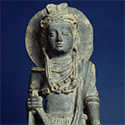|
|
| Show All 80 Results (Text Only) |
|
| Wutaishan: Pilgrimage to Five Peak Mountain |
|
| Rubin Museum of Art
|
"The sacred mountain Wutaishan (Mount Wutai), located in Shanxi Province, China, is believed to be the earthly abode of the Bodhisattva of Wisdom, Manjushri, and for a thousand years it has been a focus of transnational pilgrimage for the Chinese, Tibetans, Mongols, and Manchus alike." This online archive of a 2007 exhibition features an excellent interactive tool for viewing the "focal point of the exhibition: ... an intricately-detailed, hand-painted woodblock print map of Wutaishan, created in the 19th century by a Mongolian monk at a monastery on Wutaishan, called Cifusi. Six feet wide, this rare map offers a panoramic view of Wutaishan, which can be read as both a primary historical record of the lay of the land and as a declaration of the political primacy of Tibetan and Mongolian Buddhism, claiming Mongolian ethnic and sectarian identity over the mountain."
Go to Museum Resource: http://www.himalayanart.org/search/set.cfm?setID=1274 | |
|
|
| The Arts of Kashmir |
|
| Asia Society
|
"The Arts of Kashmir comprises works of Buddhist, Hindu, and Islamic art, including sculpture, painting, and calligraphy loaned from collections in the U.S., Europe, and India. Many of the objects have never been seen outside of India; in some cases they have never been exhibited or published anywhere. To provide a sense of the broad artistic contributions of this famously lush and beautiful region, the exhibition includes examples of stone and bronze sculptures and manuscript paintings, in addition to the fine examples of papier-mâché, carpets, shawls, and embroidery for which Kashmir is renowned."
Go to Museum Resource: http://sites.asiasociety.org/arts/kashmir/ | |
|
|
| The Arts of Thailand |
|
| Victoria and Albert Museum
|
An introduction to the V&A's new Arts of Thailand exhibit, which "features the museum's finest Thai Buddhist sculptures in bronze and stone spanning the period from the 7th to the 19th centuries, together with works of decorative art in a wide variety of media associated both with the Thai court and with monasteries." Thirty-eight objects are featured online; all objects have descriptions.
Go to Museum Resource: http://www.vam.ac.uk/content/articles/t/the-arts-of-thailand/ | |
|
|
|
| Beliefs Made Visible: Understanding Hindu and Buddhist Art in South Asia [PDF] |
|
| Asian Art Museum of San Francisco
|
"Explore the basic tenets and influences of Hinduism and Buddhism throughout Asia. Special attention is given to the evolution of Hinduism and Buddhism in India, and the representation of these beliefs in sculpture and religious architecture (stupas, temples, caves, and so on). Includes lessons on the traditions of threshold art and handouts on the symbolic gestures of Buddhas."
Go to Museum Resource: https://education.asianart.org/wp-content/uploads/sites/6/2019/09/Beliefs-Made-... | |
|
|
| Buddhist Art from China and Japan |
|
| The Cleveland Museum of Art
|
This lesson explores new objectives for art and examines how Chinese painting reflects Buddhist principles. Students learn to consider the meaning and significance of Buddhist mudras through the examination of images from the Cleveland Museum of Art.
Go to Museum Resource: http://www.clevelandart.org/lesson-plan-packet/buddhist-art-china-and-japan | |
|
|
| Buddhist Art in Asia |
|
| Ackland Art Museum, University of North Carolina at Chapel Hill
|
Learn about 12 Buddhist works of art in the Johnson Museum's collection. This website explores the rich visual language that Asian cultures have used to convey Buddhist teachings and the history of Buddhism from its beginnings in India and its spread throughout East and Southeast Asia. Click the picture to start exploring.
Go to Museum Resource: https://museum.cornell.edu/buddhist/ | |
|
|
| Buddhist Caves at Ajanta |
|
| Asian Art Museum of San Francisco
|
Learn about Buddhist caves. This is one of a series of caves excavated out of the volcanic rock that extends along a cliff overlooking the Wagora River at Ajanta, about two hours north of the present-day city of Aurangabad, in Maharastra state in western India.
Go to Museum Resource: https://education.asianart.org/resources/buddhist-caves-at-ajanta/ | |
|
|
|
| Show All 80 Results (Text Only) |








